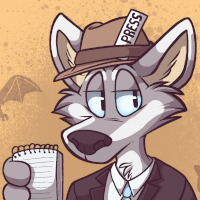GeneStorm: City in the Sky, by Paul Kidd – book review by Fred Patten.
by Patch O'Furr
Submitted by Fred Patten, Furry’s favorite historian and reviewer.
GeneStorm: City in the Sky, by Paul Kidd
Raleigh, NC, Lulu.com/Perth, Western Australia, Kitsune Press, May 2015, trade paperback $26.37 (420 pages), Kindle $7.99.
 This is based upon Kidd’s own new GeneStorm role-playing game, which seems to be similar to TSR/Wizards of the Coast’s 1978 Gamma World RPG. Kidd wrote an authorized Gamma World paperback novel, the rollicking adventure Red Sails in the Fallout (Wizards of the Coast, July 2011), featuring Xoota, a mutated quoll-woman, and her partner Shaani, “a mutant albino lab rat with an enthusiasm for scientific research and a Pommy accent”. It was set in the Australian desert near where Kidd lives. (Perth, Western Australia. He was the first Guest of Honour at Perth furry fandom’s annual FurWAG convention.)
This is based upon Kidd’s own new GeneStorm role-playing game, which seems to be similar to TSR/Wizards of the Coast’s 1978 Gamma World RPG. Kidd wrote an authorized Gamma World paperback novel, the rollicking adventure Red Sails in the Fallout (Wizards of the Coast, July 2011), featuring Xoota, a mutated quoll-woman, and her partner Shaani, “a mutant albino lab rat with an enthusiasm for scientific research and a Pommy accent”. It was set in the Australian desert near where Kidd lives. (Perth, Western Australia. He was the first Guest of Honour at Perth furry fandom’s annual FurWAG convention.)
Somebody sniffed that they would never read a novel hacked out as a RPG merchandising spin-off. Your loss. Kidd writes fun furry adventures.
GeneStorm: City in the Sky is set in the Australian “weird-lands” 150 years after the GeneStorm plague has transformed the world entirely. Everyone is a mutated hybrid. The protagonist is Snapper, a female half-human, half-shark. She rides a giant cocatoo. (It sounds very similar to the real one at the Further Confusion 2001 exotic animal life-drawing session that kept squawking for attention, trying to upstage the white tiger. See the cover by Kalahari.) Other characters are a blend of human/fox/golden pheasant, human/kingfisher/cat, human/tortoise/god knows what:
“Snapper ate the salty dough, dunking it in a cup of brown onion gravy. “I met a toucan once. Sort of part cat, part bird.’ […] ‘Now she married a guy that was a sort of strawberry-dog hybrid. Well – their kid sort of stayed a cat toucan. But his feathers were al red and green strawberry colours. Pretty striking.’” (pgs. 64-65).
Some can only be described:









 Not sure if the times are ripe for a dedicated furry art gallery, but for what it’s worth I’m having some success entering furry paintings in local art shows… I’m also making a bet that a market niche for paintings actually exists within the the fandom and that a decent number of fans would like to own furry art which can be displayed alongside other kinds of art. The results are very encouraging so far.
Not sure if the times are ripe for a dedicated furry art gallery, but for what it’s worth I’m having some success entering furry paintings in local art shows… I’m also making a bet that a market niche for paintings actually exists within the the fandom and that a decent number of fans would like to own furry art which can be displayed alongside other kinds of art. The results are very encouraging so far.

